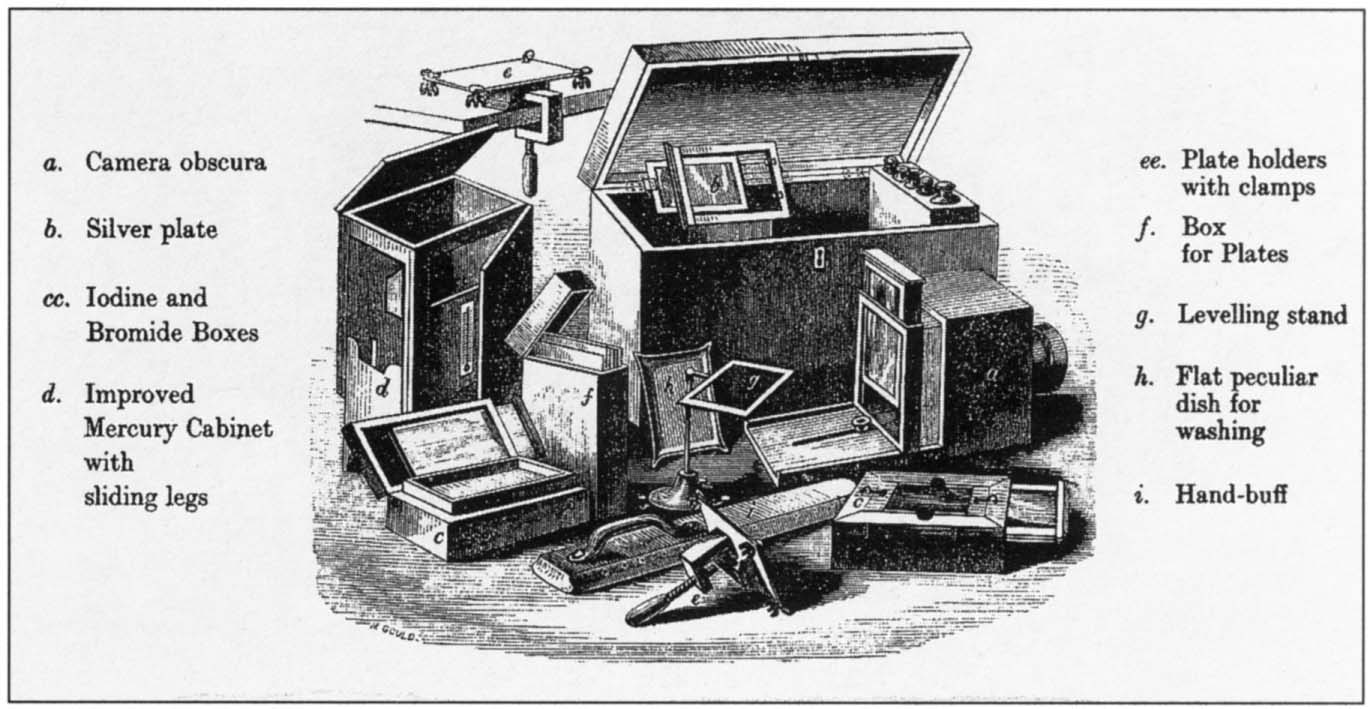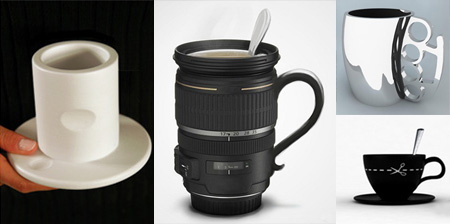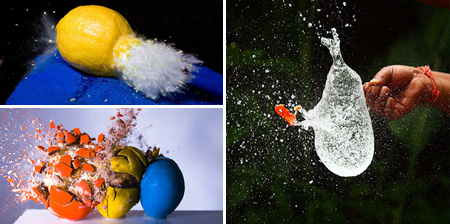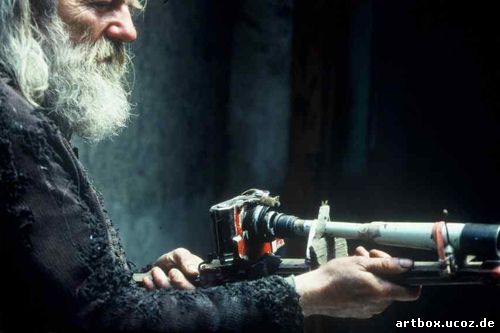Форма входа |
|---|
Поиск по сайту |
|---|
Категории | ||||
|---|---|---|---|---|
|
Помощь сайту |
|---|
Amazon |
|---|
Mini chat |
|---|
Статистика |
|---|
ART БИБЛИОТЕКА
СТАТЬИ
| Главная » Статьи |
| Всего материалов в каталоге: 106 Показано материалов: 21-30 |
Страницы: « 1 2 3 4 5 ... 10 11 » |
|
In the late 1800s and early 1900s, we saw a boom in the design and production of cameras concealed in everyday objects. Many of these cameras were sold for detective works, whereas some (like the matchbox camera) were designed specifically for spying activities. For a fantastic collection of vintage cameras, it’s hard to beat George Eastman House’s online archive: Link |
|
Do All of a Galloping Horse’s Hooves Leave the Ground? In 1872, Eadweard Muybridge, a British-born photographer, was hired by Leland Stanford (who later founded the university), to settle a question (some people say a $25,000 bet) whether there was a point in a horse’s full gallop where all four hooves were off the ground. Muybridge arranged 12 cameras alongside a race track and attached a string to the camera switches across the track. When the horse ran through the string, it triggered the shot. The series of photographs showed that indeed, all four hooves leave the ground when the horse is in full gallop. Muybridge went on to develop systems and techniques to photograph motion of people and animal. |
|
Louis Jacques Mande DAGUERRE (1787-1851) The daguerreotype process was the first practicable method of obtaining permanent images with a camera. The man who gave his name to the process and perfected the method of producing direct positive images on a silver-coated copper plate was Louis Jacques Mande Daguerre, a French artist and scenic painter. Daguerre had began experimenting with ways of fixing the images formed by the camera obscura around 1824, but in 1829 he entered into partnership with Joseph Nicephore Niepce (1765-1833), a French amateur scientist and inventor who, in 1826, had succeeded in securing a picture of the view from his window by using a a camera obscura and a pewter plate coated with bitumen. Niepce called his picture-making process heliography ("sun drawing"), but although he had managed to produce a permanent image using a camera, the exposure time was around 8 hours. Niepce later abandoned pewter plates in favour of silver-plated sheets of copper and discovered that the vapour from iodine reacted with the silver coating to produce silver iodide, a light sensitive compound. After the death of Niepce in 1833, Daguerre continued to experiment with copper plates coated with silver iodide to produce direct positive pictures. Daguerre discovered that the latent image on an exposed plate could be brought out or "developed" with the fumes from warmed mercury. The use of mercury vapour meant that photographic images could be produced in twenty to thirty minutes rather than hours. In 1837, Daguerre found a way of "fixing" the photographic images with a solution of common salt. Two years later, he followed the suggestion of Sir John Herschel (1792-1871) and adopted hyposulphate of soda (now thiosulphate of soda ) as the fixing agent. Daguerre began making successful pictures using his improved process from 1837. On 19th August,1839, at a meeting in Paris, the Daguerreotype Process was revealed to the world. In England, Richard Beard (1801-1885), a former coal merchant and patent speculator, bought the patent to Alexander Wolcott's mirror camera and employed the services of John Frederick Goddard (1795-1866), a chemist, to find a way of reducing exposure times to less than a few minutes, thereby making it possible to take daguerreotype portraits. On 23rd March 1841, Richard Beard opened England�s first daguerreotype portrait studio in London's Regent Street. In June 1841, Beard purchased from Daguerre the patent rights to the daguerreotype process in England.
|
|
Modern mugs and creative mug designs from all over the world. |
|
High speed photography can be described as the science of taking pictures of very fast phenomena. It allows photographers to “freeze time” and capture spectacular images. |
 |
 |
 |
|
Оригинальная реклама острых ножей. Смотришь и веришь в их остроту. :) 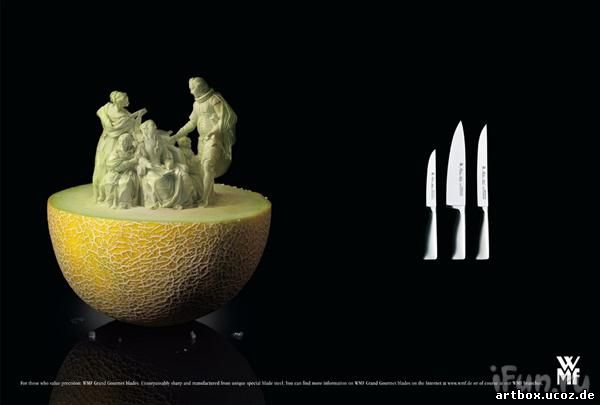 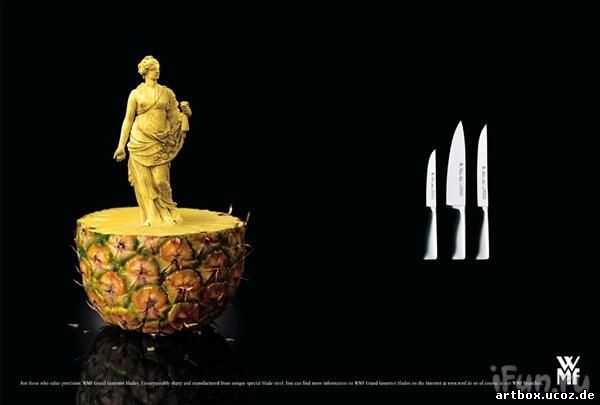 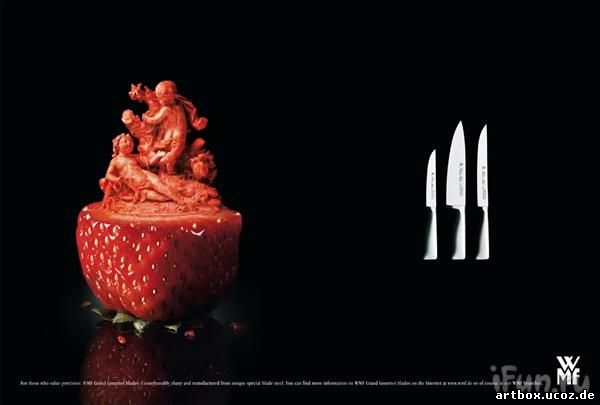 |
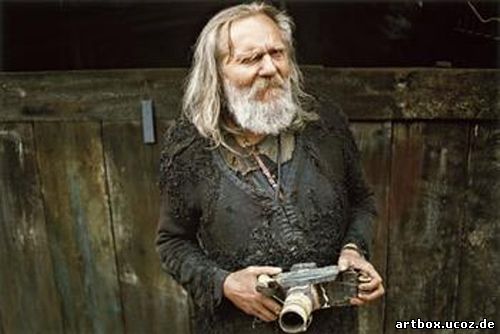 Сейчас об этом многие уже не помнят, наверное, но классическая
литература подарила нам универсальный образ Настоящего Художника. Этот
Художник должен был быть нищим, голодным, непременно безумным и всё
своё время и внимание отдавать единственной страсти - Искусству.
Непременно с большой буквы. Причем, это персонаж в маске автора
понимал, что речь идёт об Искусстве, а сам Настоящий Художник не тратил
время на рефлексию в общепринятых пошлых терминах - он просто творил и
творил как одержимый, каковым, по сути, и являлся. Наше время более
либерально, даже анархично и не навязывает нам единственно верного
образа. Сегодня настоящий художник - это, например, тот, кто хорошо
продаётся, кого патронирует успешный галерист. Или настоящий художник -
тот, кто выражает собственные чувства и эмоции в свободное от работы в
офисе время. Человек, держащий нос по ветру и вовремя реагирующий тем
или иным изобразительным рядом на финты социума, - тоже настоящий
художник. Одержимый художник, живущий впроголодь и долбящий в одну
точку мира, как дятел в кору, меньше интересует наше сытое время, но,
тем не менее, за ним тоже оставлено право называться Настоящим. По
меньшей мере, часть критиков непременно назовёт его так. Иные, правда,
сойдутся на том, что речь всё же о маньяке и лузере. И третья часть
заметит, что этот человек интересен не столько как художник, сколько
как предмет искусства. Мирослав Тихий, о котором мы упомянули в начале
этой записи, как раз такой - Настоящий Художник из прошлого, лузер и
предмет искусства. 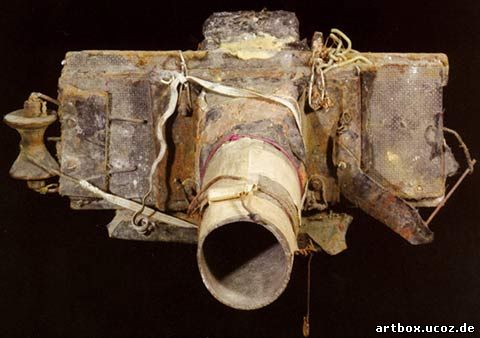 Фотокамера Мирослава Тихого Фотокамера Мирослава Тихого
Свои фотоаппараты он делал из мусора - из коробок, обрывков газет, картонных валиков, оставшихся от рулонов туалетной бумаги. Линзы он тоже делал сам - вытачивал из оргстекла и полировал зубной пастой. С этими убийственными мусорными камерами он, одетый в лохмотья, каждый день на протяжении многих лет выходил в город. Вот так это выглядело:
|



